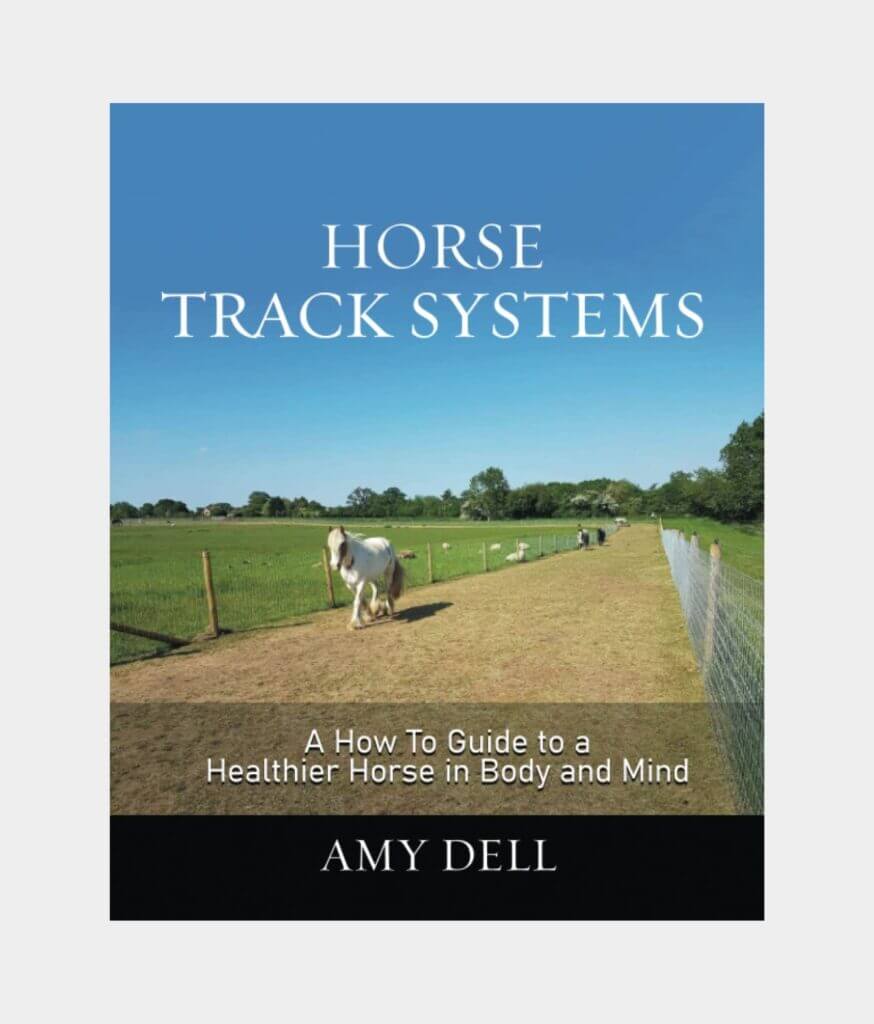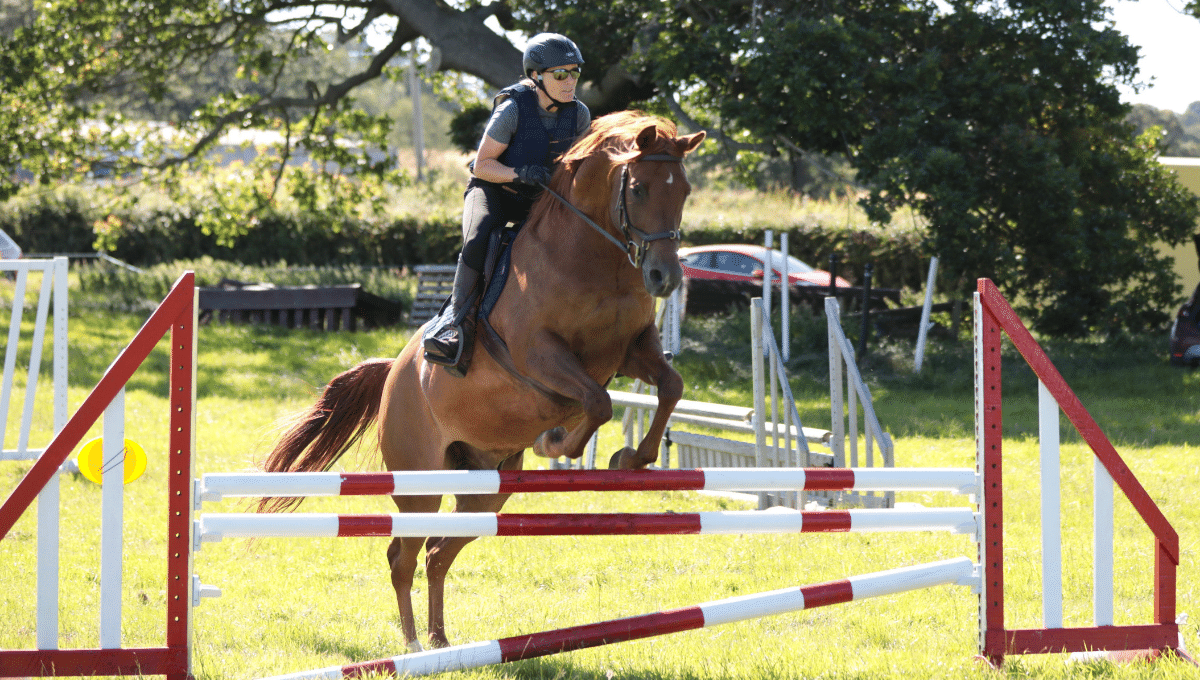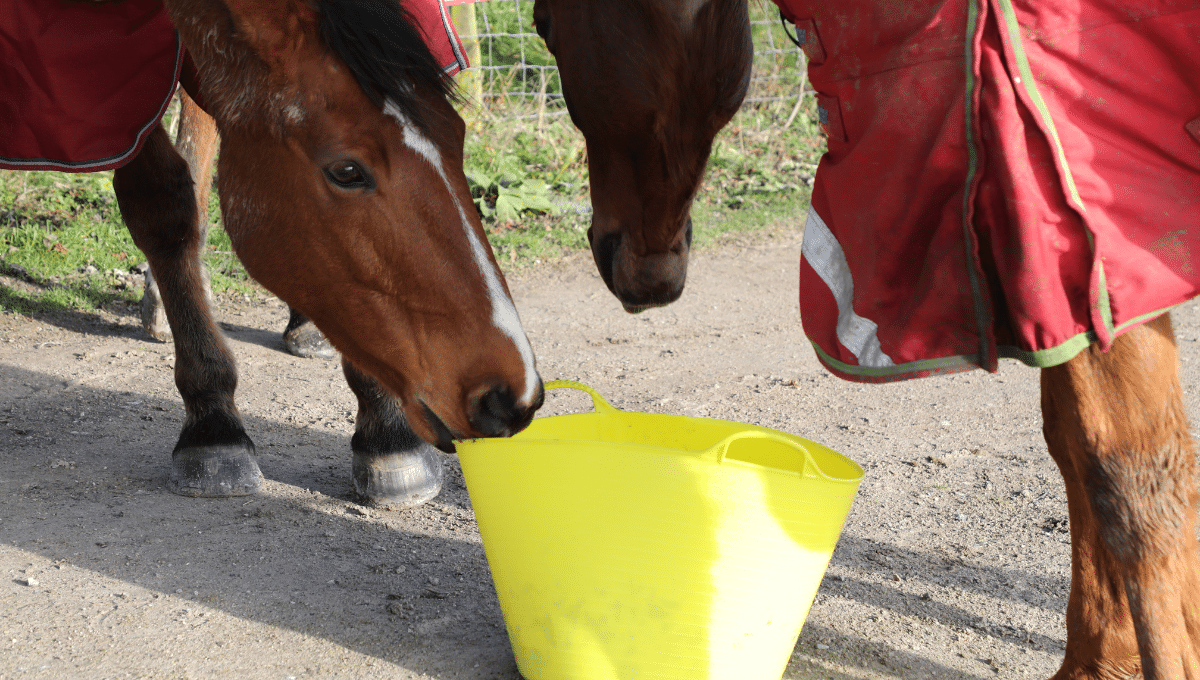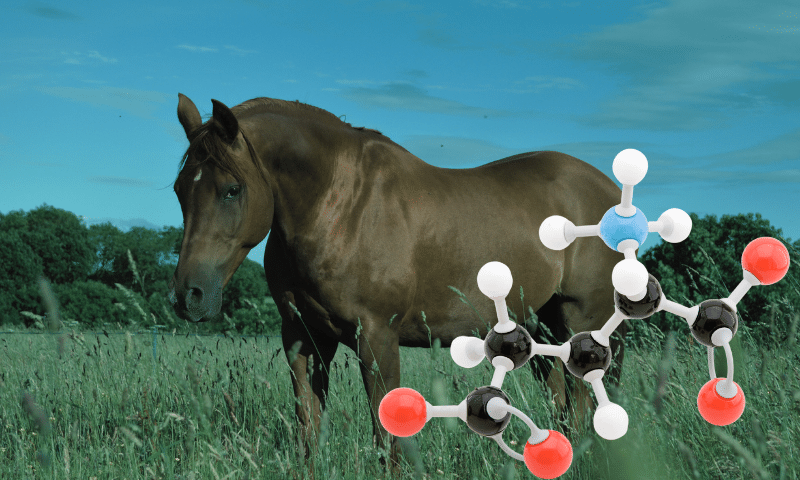Horse track systems are a way of keeping horses so they can maintain weight and avoid laminitis events. Horse track environments provide an essential species-appropriate lifestyle through a variety of different ways. The drawback is horse tracks can be costly to set up.
In this article, Amy Dell discusses ten budget ideas to help you set up a horse-appropriate living environment and the best horse track without it costing a fortune.
Amy Dell is the author of the best-selling book Horse Track Systems: A How-To Guide to a Healthier Horse in Body and Mind. She is also the founder and manager of a successful track system livery, Abbotts View Livery: Barefoot and Back to Nature.
What are track systems for horses?
A horse track system was first explored by Jaime Jackson after observing wild horses living in Western USA. He conceived the ‘Paddock Paradise’ track system as a way to mimic the way wild horses lived in their natural environment and give domestic horses more movement, more interaction as a herd and manage weight through lifestyle.
Instead of horses being turned out in square fields a track is created around the perimeter, with shelter, water and feeding stations being situated to encourage movement and natural herd behaviour.
Horse tracks can support horses in ensuring they have access to the basic three ‘Fs’, as devised by equine behaviourist, Lauren Fraser Mac, CHBC. These are:
- Freedom: This covers physical and mental freedom. The ability to have free choice movement when making decisions about sheltering, eating, sleeping and playing.
- Forage: This covers access to a constant supply of species-appropriate and safe forage (low sugar/starch hays)
- Friends: As a highly social, herd-orientated animal, horses need companionship including touch with other horses
What are the benefits of keeping horses on a track system?
When I first trialled a track system, it was on one acre, with temporary fencing and features.
The changes in my horse were astronomical! After struggling for years with my horse’s weight, trying
every option under the sun from muzzles to strip grazing, I finally found a solution that allowed me
to have a horse that was both a good weight and happy. My horse was able to live in a free-choice environment and perform natural behaviours without restriction. This helped his whole health.
I feel there are 8 key benefits to keeping horses on a track. A horse track system:
- Increases movement whilst reducing grass intake
- Allows you to feed more species-appropriate forage
- Mimics the horses natural environment
- Allows horses to express their natural behaviours
- Discourages vices
- Creates a stimulating and enriched environment for the horse
- Allows 24/7 turnout 365 days of the year
- Has many health benefits including a lower risk of our most common health problems, including laminitis and colic
1. How do you make a horse track system on a budget?
A horse track system, like a ‘Paddock Paradise’, does not need to be big and fancy, or expensive. It’s very easy to google horse track systems and feel put off by the photos of fully surfaced tracks. These tracks may have large sand pits, water features and various enrichment features (hills, bridges and more), but you can create something with the same results without breaking the bank or investing an enormous amount of money.
Even if you are planning to create a permanent horse track system eventually, my advice would be to
always start with a temporary one. It is impossible to know how it will work without trying it. Without a trial, you won’t know which areas of the land drain well, and which areas drain poorly.
You won’t know where the horses prefer to lie down or where their favourite toilet spot is. Imagine building an expensive sand pit only to find you have situated it in the boggiest area or the area that the horses like to use as a poo spot. Planning is important to avoid costly mistakes.
You may find you want to move certain parts of the horse track fencing to make the track thinner or wider to promote movement or make it safer.
2. How much space do you need for a budget horse track system?
You do not need a lot of land to make a budget ‘Paddock Paradise’ type horse track. If anything, having a smaller amount to work with will be easier to keep grass free and utilise the space.
The only time you may have trouble will be in the winter when winter rain may create pouching and muddy areas. This is more the case if your soil is more clay-based, prone to holding water and turning to mud, but this can be managed with temporary surface options.
3. What is the best budget horse track layout?
It is tempting with a horse track system to do lots of twists and turns to make things interesting, but it is best to keep things simple.
Following the perimeter of your land by putting in a second horse track fence line in, is often the best course of action. This will allow you to utilise most of the space, making a longer track, and also allow for easier access to the track middle for pasture management or creating a play, horse training area in the centre.
Think about machinery or livestock access if you need to get a tractor or other livestock in the middle area. Make sure gateways are wide enough and situated so that it will be easy to drive a tractor in there. If the track cuts right across the middle this won’t be ideal for manoeuvring the tractor and the horses will also use it as a cut-through to get to resources. You will find whatever is the shortest route is the one the horses will use.
4. How wide should a horse track system be??
The width of your horse track will depend upon how many horses you are planning on having on your track and horse size. The width can also be wider in some areas where hay feeders, water or sleeping areas are located.
The narrower the track, the less grass if it is not surfaced. The narrower the track the more movement the horses will have. However, if the track is too narrow this can cause horses to be too close together and there can be more conflicts over space and resource guarding can occur over food.
As a general rule of thumb, it is recommended that no area of your track is narrower than the length of your largest horse stood sideways from nose to tail.
Corners can be wider at between 10 to 15 metres and fenced at an angle to allow for ease of turning for horses and vehicles and machinery.
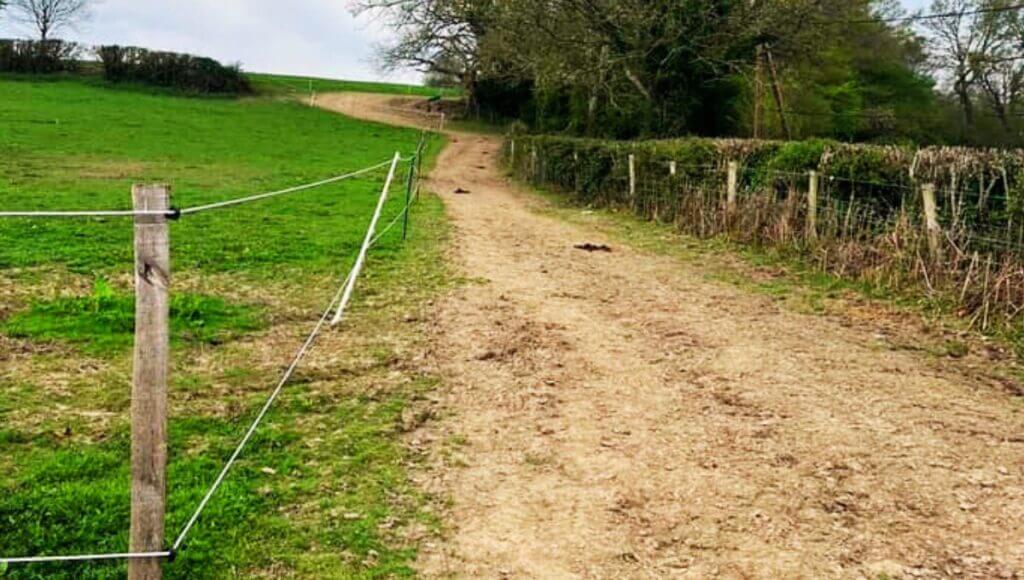
5. What is the best budget horse track fencing?
For a temporary, budget track, my choice would be electric rope with plastic posts and wooden
posts whacked in by hand, in corners.
The most important part of making electric fencing safe is using safety release clips. These are joiners that will break upon impact, freeing a trapped horse and preventing injury. Electric fence injuries can be life-changing and sometimes even fatal, so this is of utmost importance.
There is not yet a safety clip on the market for electric tape, which is why I recommend rope. The best ones on the market are the Litzclip electric fence connectors. These are the best safety release clips for horse tracks.
Post-wise, plastic posts are great for long straight sections. Corners, or anywhere where the fence
changes direction, should be secured with wooden posts and electric fence insulators. These can
be whacked in by hand using a handheld post whacker so no need to hire in an expensive fencer.
Plastic posts in the corners will cause the post to bend and the fencing to sag. Keeping the fence taunt is
extremely important for safety reasons. A sagging fencing looks tempting to walk or jump over and is much easier for a horse to go through. A sagging horse track fence will also not allow break-away safety points to work effectively.
6. Can I use a temporary horse track surface?
Temporary surfaces are useful for horse tracks if you are on a budget. Temporary surfaces chosen if you cannot put a permanent surface down due to planning permission, not owning the land, or being on livery.
What is the best temporary horse track surface?
The best temporary horse track surface would be some sort of mud mat. Mudcontrol mats are a popular solution that you can easily put down by hand, lift up and re-use. They hold their value well and can often be resold for almost the same amount you bought them for if they ever are no longer used. They can
be put down straight onto the ground without any preparation other than flattening the land.
For best results, lay mud mats in the spring or summer when the ground is dry. Then top with sand or bedding to make them anti-slip and stop any grass growing through.
Another brand of mud mats are Jelka ground mats but they are slightly bigger and harder to lay, however, they do not allow any grass to grow through them.
Can I use AstroTurf on a horse track?
Another option is using recycled Astro Turf but I would only recommend its use in loafing areas, as it can be slippy once worn and where horses walk mud onto it. You also need to consider the cost of removal in the future as Astro Turf must be disposed of using special measures and can’t go to a normal tip or recycle centre. It is unlikely you will be able to re-sell it.
Where is the best place to put a temporary horse track surface?
Place your temporary surface around the highest traffic areas. This will be where the hay, shelter and water are. These will be the most horse-visited places, so ground reinforcement is a must in winter.
For the best horse track, budget options, the best bet is to make a hardstanding area big enough for all horses to use at once. This area can contain a water trough, a shelter and somewhere you can feed hay in the winter.
In the spring, summer and autumn you can spread hay around the unsurfaced areas of track
to promote movement and enrichment. In the winter moving it to the hardstanding area will prevent too
much poaching and mud (but remember you want some mud to get rid of the grass).
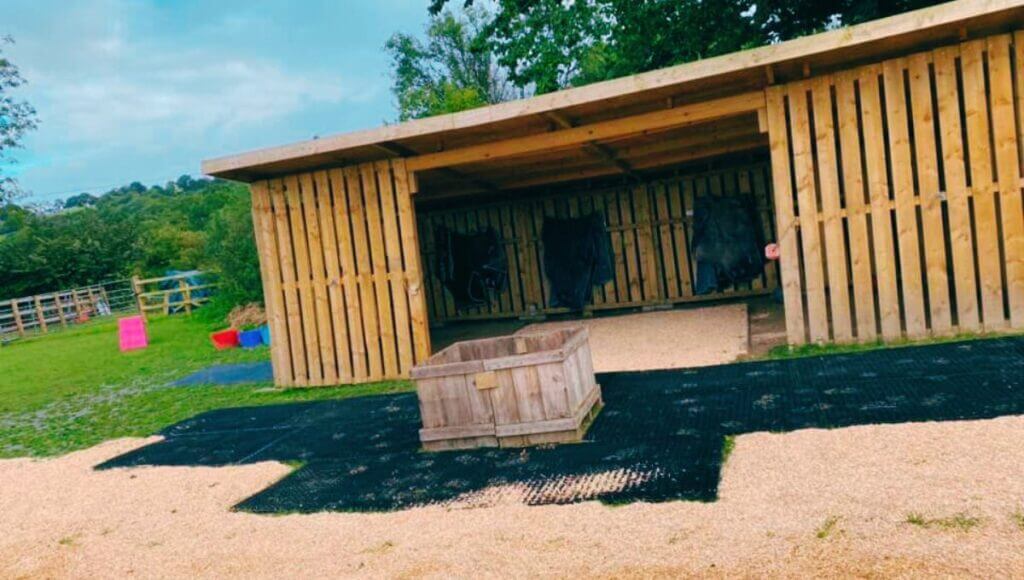
7. What is the best budget shelter for a horse on a track system?
The best budget shelter for horses is a free one made of hedgerows and trees. If you have any on your land and they are horse-safe species, consider incorporating these into your track.
If you do not have any natural shelter, shade sails from Amazon or from local garden centres are a great option for temporary summer shelter, but must be taken down in the winter. Putting up fence panels against the outer fence line can make great windbreaks for winter.
If you can stretch to it, and planning permits, a mobile field shelter is your best bet. Make sure it is large enough for your horses to use together and not get trapped in. For safety, it is best to move partitions if you have a number of horses using the same shelter.
8. How do I get rid of grass on a horse track system?
The best way to get rid of the grass is using the horses hooves! On my track, I encourage the
horses to use the unsurfaced areas of the track in the winter in order to churn up the grassroots
in preparation for spring.
However, it is a fine art to get it right, as you don’t want the horses in mud any higher than their hooves but it doesn’t need to get that deep to achieve a grass-free track.
9. How can I make a cheap hay station for my horse?
The cheapest way to make hay stations is to buy some wooden boxes and fix hay nets inside. You
can get these on eBay or Facebook Marketplace. This will keep horses eating in a natural ‘head
down’ position, whilst keeping the hay nets mud and dropping free. The boxes also eliminate the risk of horses urinating on the hay.
Loose hay on the ground is the ideal place to pee and that can be expensive for you in spoiled hay. If you have trees and hedgerows you can hide loose hay inside then branches or fix a hanger from the tree from which to hang a net.
I wouldn’t recommend attaching hay nets to fence posts. Fence posts can snap unless they are big corner posts or telegraph poles.
Horses are designed to eat little and often so investing in some good quality slow feeder hay nets
is ideal, unless your horse is a poor doer and can have loose hay.
10. How can I use enrichment ideas on a horse track?
Enriching your horse’s environment is not as intimidating as it sounds. The ultimate aim of enrichment is to improve the horse’s quality of life.
What is horse enrichment?
Enrichment simply means that a stimulating environment is provided for horses. This helps improve their mental and physical well-being by stimulating their natural instincts.
Enrichment comes in many forms and can be split into five main categories:
- Sensory
- Social
- Food based
- Environmental
- Cognitive
A horse’s mental and physical well-being can be nurtured through the exploration of smell, taste, grazing and foraging, movement and social interaction.

What are the best enrichment activities for horses?
The best form of enrichment is always other horses. Horses are gregarious, herd animals and need interaction with friends as a basic need. No horse should be kept alone unless for extreme behavioural issues.
Second to friends; foraging activities are a great form of enrichment for horses. Horses are natural foragers and browsers when grazing on pasture. If horses on a track have little to no access to grazing then plants such as cleavers, cow parsley, hawthorn, camomile and willow can be collected and spread, and hidden around the track. It’s fun to watch your horses hunt for them and enjoy them as tasty snacks.
You can also create areas to hang branches from, so leaves can be browsed. Another horse enrichment idea is to use an old bucket, hung up, with holes cut in, and filled with forage. The horses can pull the forage through the holes. You can even plant your own herb garden for the horses to self-select or for you to harvest and offer to them.
Water buffets are another great idea. Green French clay and apple cider vinegar have many beneficial properties and adding them to water allows the horses to self-select the amount they require. On hot days, offering saltwater alongside fresh water is a great way of encouraging horses to stay hydrated and preventing heat stroke. You can also buy herbal mixes online that can be stewed and made into herbal tea. There are all sorts of mixes to support different needs from respiration to hoof support.
Adding logs to the horse track to encourage horses to lift up their legs or chew on is another great addition. Speak to your local woodland, tree surgeon or even neighbours (in case they are having a tree removed) to source some.
Where can I learn more about horse track systems?
My how-to guide book ‘Horse Track Systems’ goes into 227 pages of detail on developing and managing horses on a track system. It tells you how you can create, build or improve your own track, for your horses, or as a livery business.
The book provides:
- Track system template diagrams and ideas
- Detailed descriptions and step-by-step instructions on different surface options and how to implement them
- Information on introducing new horses to a track herd
- Which are the best hay nets to use on a track system
- Further information on creating points of enrichment to create healthy, happy horses
- How to feed horses for the best health on a track system
- Pitfalls and mistakes you shouldn’t make
- Running a track system as a horse business
Most of all a horse track system needn’t be expensive or permanent. Start small, keep learning and keep things interesting. Most of all observe and pay great attention to your horses. Horses are our greatest teachers, let them tell you what works and what doesn’t.
If you need help, I offer a consultancy service. From my experience, through trial and error and some expensive and emotionally draining mistakes along the way, I can help to ensure you don’t make the same mistakes too! Find out more about what I offer here.
A ‘How To’ Guide to a Healthier Horse in Body and Mind
